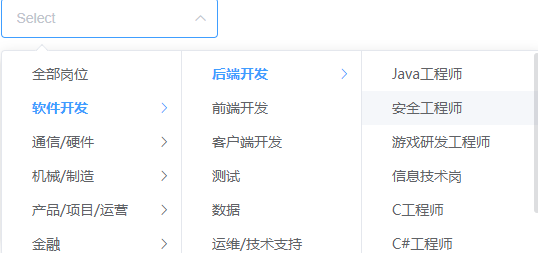文章目录
- 实现级联选择框
- 效果图
- 实现
- 前端
- 工具版本
- 添加依赖
- main.js导入依赖
- 级联选择框样式
- 后端
- 数据库设计
实现级联选择框
效果图

实现
前端
工具版本
- node.js v16.6.0
- vue3
级联选择框使用 Element-Plus 实现
添加依赖
在 package.json 添加依赖,并 npm i 导入
"element-plus": "^1.1.0-beta.15",
main.js导入依赖
import ElementPlus from 'element-plus'
import 'element-plus/dist/index.css'
import { createApp } from 'vue'; // 使用 createApp 替换 Vue 的导入方式
import App from './App.vue';... const app = createApp(App); // 使用 createApp 创建 Vue 应用
app.use(ElementPlus)
app.mount('#app'); // 挂载 Vue 应用到 DOM 节点
级联选择框样式
<template><div><el-cascaderv-model="value":options="options"@change="handleChange"collapse-tags-tooltip="true":props="props"expandTrigger="hover"/> </div>
</template>
<script setup>// 级联选择框
const props = {expandTrigger: 'hover'
}
const handleChange = (value) => {let jobId = value[value.length - 1]let condition = {pageNo: page.value,pageSize: size.value,param: {jobId: jobId}}getListDataByCondition(condition)
}
// 获取级联筛选框数据,如果后端的话,使用后端数据替换 options 即可
const options = [{value: 'guide',label: 'Guide',children: [{value: 'disciplines',label: 'Disciplines',children: [{value: 'consistency',label: 'Consistency',},{value: 'feedback',label: 'Feedback',},{value: 'efficiency',label: 'Efficiency',},{value: 'controllability',label: 'Controllability',},],},],},{value: 'python',label: 'python',children: [{value: 'disciplines',label: 'Disciplines',children: [{value: 'consistency',label: 'Consistency',},{value: 'feedback',label: 'Feedback',},{value: 'efficiency',label: 'Efficiency',},{value: 'controllability',label: 'Controllability',},],},]}
]
</script>
options 即为级联选择框展示的数据,后端返回对应数据即可,如下
{label: '...',value: '...',childred: [{}]
}
后端
数据库设计
假设数据库表名为 career
则字段为:
id、name、parent_id
我们设计最顶层的条件的 parent_id 为 null,后端使用递归查出即可
这里只列出 Service 层相关方法:
这里使用了 JSONArray,引入 fastjson 依赖即可。
<dependency><groupId>com.alibaba</groupId><artifactId>fastjson</artifactId><version>1.2.75</version>
</dependency>
@Override
public JSONArray getData() {QueryWrapper<Career> qw = new QueryWrapper<>();// 查出 career 表中所有数据List<Career> careers = careerMapper.selectList(qw);// 进行递归解析JSONArray result = resolve(careers, null);return result;
}public JSONArray resolve(List<Career> careers, Integer parentId) {JSONArray curResult = new JSONArray();for (Career career : careers) {JSONObject obj = new JSONObject();obj.put("value", career.getId());obj.put("label", career.getName());// 根节点if (career.getParentId() == null && parentId == null) {JSONArray children = resolve(careers, career.getId());if (children != null && children.size() > 0) {obj.put("children", children);}curResult.add(obj);} else if (career.getParentId() != null && parentId != null && career.getParentId().equals(parentId)){JSONArray children = resolve(careers, career.getId());if (children != null && children.size() > 0) {obj.put("children", children);}curResult.add(obj);}}return curResult;
}
数据库模拟数据如下:
id: 1, name: "软件开发", "parent_id": null
id: 2, name: "后端开发", "parent_id": 1
id: 3, name: "前端开发", "parent_id": 2
id: 4, name: "Java开发", "parent_id": 2
id: 5, name: "Go开发", "parent_id": 2
id: 6, name: "Vue", "parent_id": 3





![[数据集][目标检测]天牛数据集目标检测数据集VOC格式3050张](http://pic.xiahunao.cn/[数据集][目标检测]天牛数据集目标检测数据集VOC格式3050张)




的解决方法)


)


)


